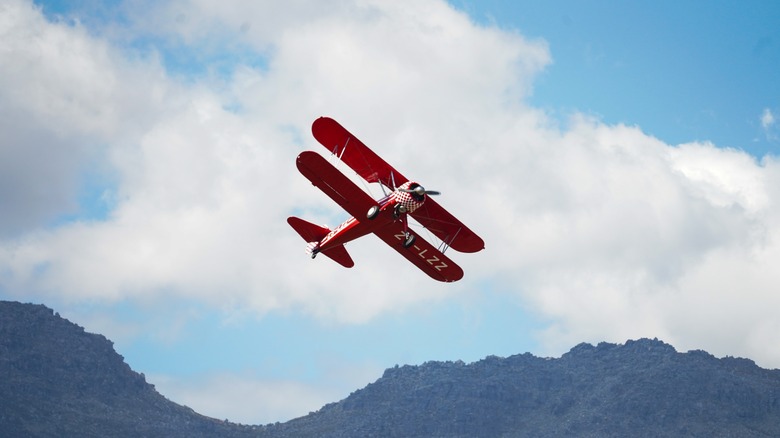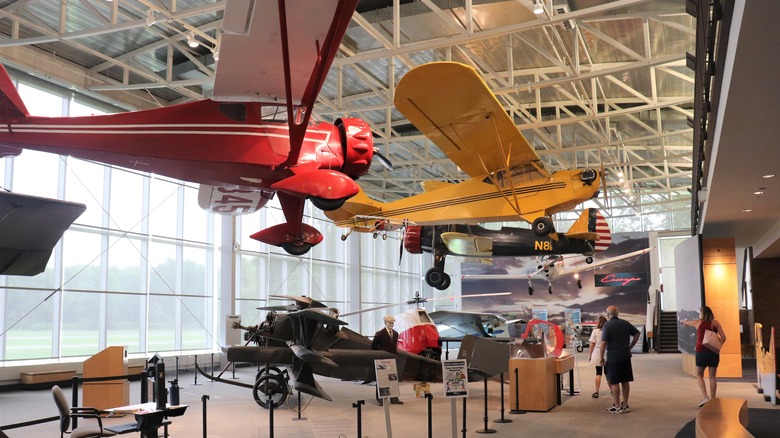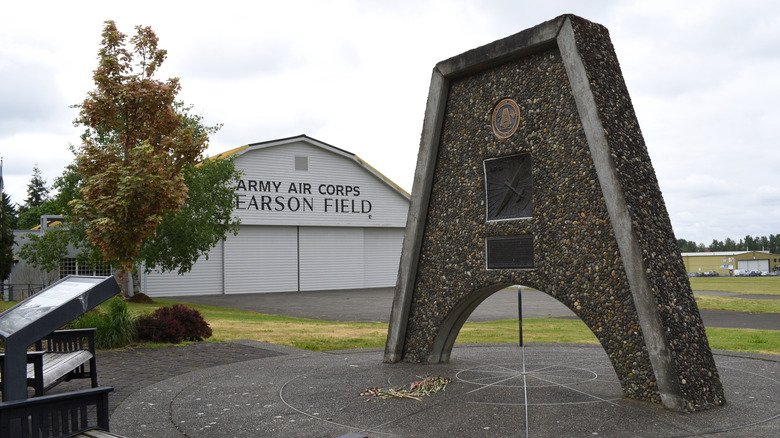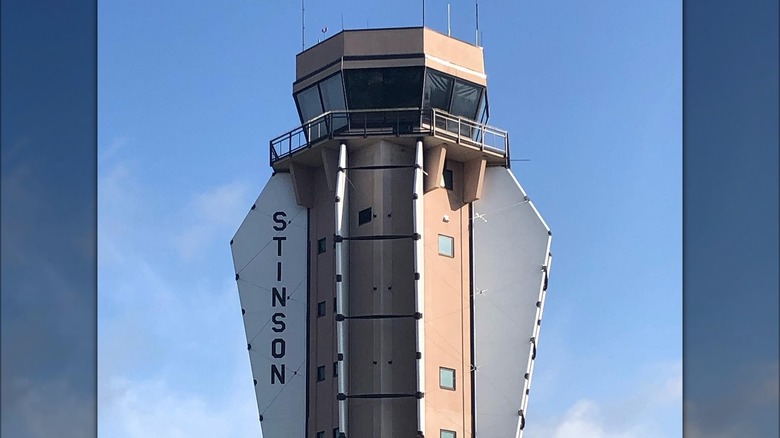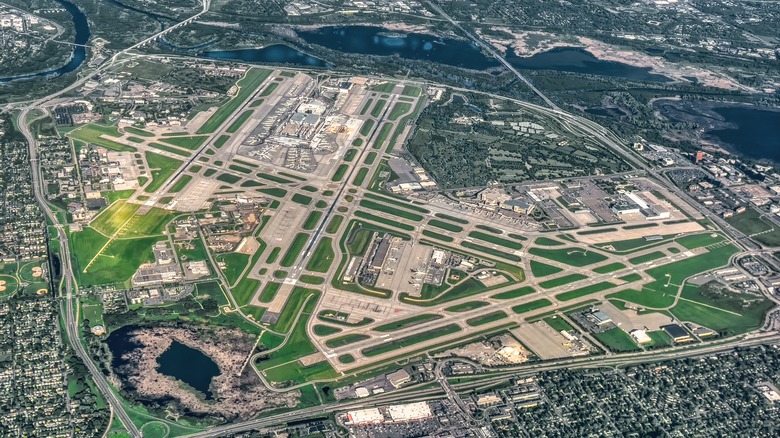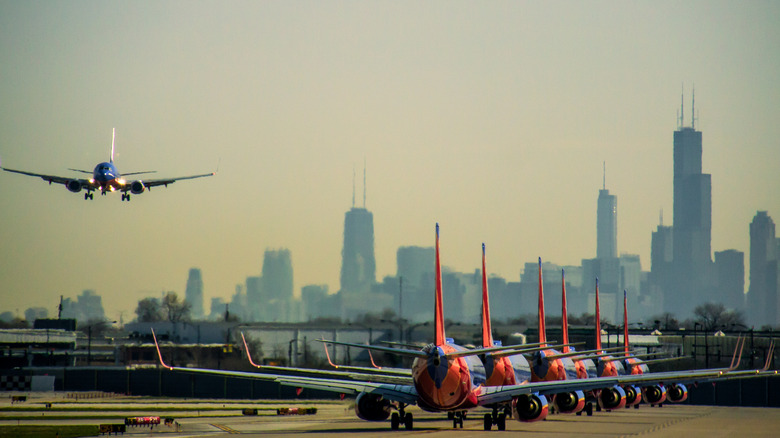The 5 Oldest Airports In America
Can we all take a moment to truly appreciate the incredible transportation forum that is the airport, aka the modern-day magic carpet? Think about it: with only some dollars and an ID in hand (a toothbrush, if you must), you set one foot within this ingenious travel machine, and whoosh, you are whirled thousands of miles from little-town Michigan to tropical Buenos Aires, with only a misplaced sense of time. From the extremely biased perspective of an avid traveler, is there any equivalent to this miracle?
But before flying became so commercialized, affordable, and accessible to the general public — hard to imagine for newer generations — do you wonder what the first airports were like? Where did the phenomenon of sky-high wizardry and traveling by plane first take off (pun, anyone?) in the U.S.? What was the very first airport built in the United States? Is it still operating? Let's check out the five oldest airports in America and the fascinating individual history behind each one.
College Park Airport – College Park, Maryland
The granddaddy of American airports: College Park Airport. Widely accepted as the oldest continuously operating airport in the United States, College Park Airport was established in 1909, less than 10 miles away from D.C. Wilbur Wright blessed its birth when he trained two military officers to fly the first government airplane there. Imagine being in their shoes! Keep in mind the very first flight was lifted out of Kitty Hawk, North Carolina, courtesy of the Wright Brothers in 1903, which means the U.S. government made quick work of getting aviation off the ground. In 1911, College Park Airport started offering civilian flights and served as the nation's first military aviation school.
Nicknamed the "Field of Firsts" due to a lengthy resume of flying firsts, College Park Airport was the site of the first mile-high flight by a powered plane, the first female passenger, the first controlled helicopter flight, and the first night landing. If that doesn't build one's ego, we don't know what does. After over 80 years of rich aviation history, College Park has a big fan base in the flying world. Today, the airport still operates and serves the needs of general aviation pilots in the Washington, D.C., metropolitan area.
Pearson Field – Vancouver, Washington
Are you ready for a bit of drama? There is a bit of beef between College Park and Pearson Field. Technically, Pearson Field (Vancouver, Washington), constructed in 1905, was the first airfield built in the country — four years earlier than College Park, to be exact. However, the reason why Pearson can not lay claim to this particular throne is that it was used as a docking station for airships, and its first flight did not take off until 1911.
Tiff aside, Pearson Field need not be ashamed. With a significant aviation history of many flying firsts and as a major base for air reserve training, Pearson attracted much national interest when the first aeronautical flight landed there. In 1924, it was a stopover on the U.S. Army's first Round-the-World flight (a big show-off moment), and in 1937, it was the final landing site of the world's first non-stop transcontinental flight by Soviet aviator Valeri Chkalov.
Pearson Field also served as the base for the aircraft that made the first aerial survey of the Grand Canyon National Park. The aviator of said flight was Lt. Alexander Pearson, who won the nation's first cross-country air race in 1919 and sadly died in 1924 while preparing for an air race. A year later, the airport was named after this highly esteemed aviator. Today, when not the subject of argumentative historians and internet trolls on whether it is the country's oldest operating airport, Pearson Field stays active with daily flights.
Stinson Municipal Airport – San Antonio, Texas
The third oldest airport in the U.S., the Stinson Municipal Airport claims a grand family history that makes the birth of this airfield unique. In 1915, the three Stinson siblings opened and operated the Stinson School of Flying in San Antonio. Their mother, Emma, managed the School. Eddie worked as a mechanic, Marjorie instructed pilots-in-training, and Katherine Stinson financed and inspired the entire project. As "America's Sweetheart of the Air," Katherine Stinson was the first female pilot to perform the in-air loop-the-loop pattern, the first female pilot to fly in Canada and Japan, and the first nighttime sky-writer when she spelled out "CAL" in the sky above Los Angeles. The Stinson School of Flying ran successfully until World War I when national aviation laws changed and restricted civilian flying. The airfield was transferred into the hands of the county and then the Air Force during World War II.
Stinson Field played many parts in San Antonio's development and history, serving as an excellent location for military pilot training, the city's mail service, and, briefly, for commercial operations. Its big brother — San Antonio International Airport — quickly overtook the area in 1941, leaving no market for commercial flights at Stinson Field. It still operates as a municipal airport with daily flights.
Minneapolis-St. Paul International Airport – St. Paul, Minnesota
The Minneapolis-St Paul International Airport, the fourth airport founded in the States, interestedly found its humble beginnings in 1914 as "Snelling Speedway" in Minneapolis (sounds like it came out of a "Harry Potter" book). It was a racetrack built not for airplanes but for cars. When this auto-racing venture ended in bankruptcy after two years, the local Minneapolis Aero Club took over the facilities in 1920, a major airmail hub began to prosper, and Snelling Speedway became Speedway Field. Along with other quickly-growing airfields during World War I and II, the airport took on its share of Air Force operations and was renamed the Wold-Chamberlain Field after two heroic pilots who died in combat.
After the dust of the war settled, the Twin Cities remained a hub for aviation, but the commercial industry was divided when a competing airfield was built in Saint Paul. Tiffs and sparks flew between the two major airlines: Delta, operating out of Wold-Chamberlain Field in Minneapolis, and Northwest Airlines, fighting neck-and-neck in the same market from Saint Paul. Eventually, they decided to play nice, shook hands, and merged forces in 1941. Northwest Airlines moved its base to Wold-Chamberlain Field in 1941. The mighty kingdom of MSP was born, and in 1948, it changed its name once again to Minneapolis-St Paul International Airport. It remains one of the most popular U.S. airports and has even been voted "Best Airport in North America." And to think, it all started with driving cars at breakneck speed in circles.
Chicago Midway International Airport – Chicago, Illinois
The fifth oldest airport in the U.S., the Chicago Municipal Airport was founded in the suburbs of the Windy City in 1927, quickly skyrocketed, and became not only the aviation center of the country but of the whole world! By 1932, Chicago Municipal had claimed the title of "busiest airport in the world," operating on naught but a single square mile. Part of the construction and expansion of the airport was due to its participation in a New Deal program, providing job opportunities to individuals during the Great Depression.
Chicago Midway (it took this name in 1949) reigned as the leading U.S. airport until 1961, when its new and fancy neighbor, the O'Hare International Airport, arrived in 1955 to take over Chicago. It was built just 15 miles away — how is that for a slap in the face? O'Hare took over so much of the market in the '60s and '70s that there was danger of Midway shutting down for good. As O'Hare expanded, Midway became a ghost airport, and it required a massive effort from Midway Airlines to keep Chicago Midway International Airport open and prosperous. While Midway Airlines eventually took a dive, other discount airlines stepped in to keep Midway a gigantic flying hub. It remains one of the busiest airports in the U.S., and Southwest Airlines now hosts 93% of its flights.
